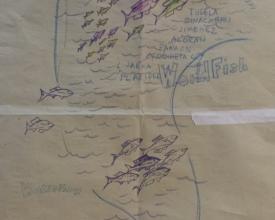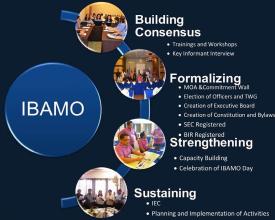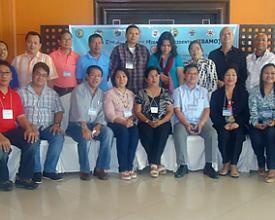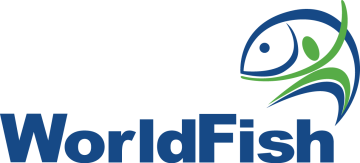Renforcer la gouvernance de la gestion de la pêche à petite échelle
Solution complète
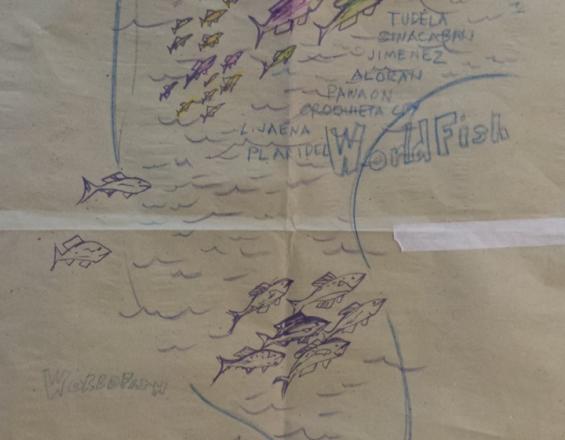
Illustration de l'histoire de l'IBAMO (© IBAMO)
Une approche écosystémique de la pêche (AEP) a été adoptée par les municipalités de Misamis Occidental, aux Philippines, afin d'améliorer la gestion de la pêche à petite échelle et de réduire la pauvreté. Elles appartiennent à l'Alliance de la baie d'Iligan de Misamis Occidental (IBAMO), une initiative qui fournit des cadres de gouvernance pour la collaboration entre les collectivités locales. Elle se veut une alliance proactive, engagée et dynamique pour le développement durable des ressources côtières et cherche à favoriser le bien-être de l'environnement et des personnes qui dépendent de la pêche.
Dernière modification 28 Mar 2019
5013 Vues
Contexte
Défis à relever
La solution vise à évaluer les dispositions institutionnelles existantes et à comprendre comment une AEP peut surmonter les obstacles à une gestion intégrée efficace des stocks de poissons et de fruits de mer. L'Alliance développe des stratégies et des actions d'AEP pour la gestion du SSF adaptées aux contextes des pays en développement et renforce la capacité des acteurs locaux de la pêche et des agences gouvernementales à collaborer et à travailler au sein d'une AEP.
Emplacement
Misamis Occidental, Philippines
Asie du Sud-Est
Traiter
Résumé du processus
La solution a été organisée en deux phases : (1) diagnostic participatif et identification des stratégies appropriées ; (2) mise en œuvre pilote collaborative des stratégies de gestion des pêcheries dans les sites focaux. Le diagnostic participatif a utilisé le PDAM et a été complété par le RAFMS pour définir la pêcherie à gérer et pour identifier ses problèmes spécifiques. Il a été suivi par la mobilisation d'un groupe de gestion ayant le plus grand potentiel pour traiter les questions prioritaires. Huit municipalités côtières ou unités de gouvernement local et la province de Misamis Occidental ont été engagées pour constituer l'IBAMO. Des ateliers ont été organisés à l'intention des parties prenantes afin de dégager un consensus et de formaliser l'alliance. La phase de recherche était essentielle pour comprendre comment les initiatives de gouvernance peuvent s'appuyer sur les connaissances préexistantes et pour définir les limites de ce qui est possible. Cette phase a abouti à l'élaboration de plans d'action pour le pilotage collaboratif des stratégies de mise en œuvre dans les sites focaux. L'inclusion de tous les groupes cibles (principalement les agents municipaux chargés du développement, de l'agriculture et de l'environnement) dans les deux phases visait à renforcer leur capacité à entreprendre des processus de diagnostic et à collaborer à la mise en œuvre de stratégies visant à améliorer la gouvernance du SSF.
Blocs de construction
Diagnostic participatif et gestion adaptative (PDAM)
Le cadre du PDAM commence par une phase de diagnostic visant à définir la pêcherie à gérer et à identifier les questions spécifiques à traiter. Les tâches clés de la phase de diagnostic sont les suivantes : (1) définir les limites de la pêcherie (1) la définition des limites de la pêcherie ; (2) l'identification des défis et des opportunités spécifiques à la pêcherie (passés, présents et futurs) ; (3) la hiérarchisation des problèmes ; (4) la définition des solutions de gestion potentielles.
Facteurs favorables
- Les parties prenantes se demandent délibérément qui doit être inclus dans la gestion adaptative.
Leçon apprise
La mobilisation des acteurs de la gestion les mieux placés pour faire face aux menaces et aux opportunités identifiées lors de la phase de diagnostic est une étape essentielle pour légitimer l'AEP et augmenter ses chances de réussite. La gestion adaptative implique ensuite la conception négociée d'un AEP intégré, ainsi que sa mise en œuvre et son évaluation par l'IBAMO.
Évaluation rapide d'un système de gestion des pêches (RAFMS)
L'approche RAFMS a été adoptée pour compléter le PDAM dans le diagnostic participatif. L'approche RAFMS se concentre sur les systèmes de gestion de la pêche et prend en compte le contexte plus large des dimensions socio-économiques, biophysiques et institutionnelles. Les résultats indiquent cinq problèmes cruciaux auxquels l'IBAMO doit s'attaquer : (1) l'épuisement des ressources halieutiques et la faiblesse des captures ; (2) la dégradation des habitats halieutiques ; (3) l'absence de moyens de subsistance alternatifs ; (4) les capacités institutionnelles limitées, notamment l'absence de programme efficace de surveillance des pêches ; (5) le manque d'harmonisation des lois et des ordonnances en matière de pêche.
Facteurs favorables
- Participation active des parties prenantes à la consultation des parties prenantes ; résultats du diagnostic participatif
Leçon apprise
Pour vérifier les données collectées, le résumé et les points saillants des résultats ont été présentés et validés dans le cadre d'une consultation des parties prenantes avec les participants des cadres provinciaux/urbains/municipaux concernés et les principaux fonctionnaires de Misamis Occidental.
Consensus et formalisation de l'alliance
La formation de l'IBAMO est basée sur des programmes antérieurs dans le domaine de la gestion des ressources côtières. Ainsi, l'établissement de partenariats et de consensus avec des institutions "extérieures" (y compris des ONG et des groupes de la société civile) et la stimulation de l'amélioration de la gouvernance de la pêche dans les sites cibles ont été réalisés en l'espace de deux ans. En 2012, les huit collectivités territoriales ont signé un nouveau protocole d'accord pour constituer l'IBAMO, ainsi que le gouvernement provincial et les bureaux régionaux de plusieurs agences gouvernementales du nord de Mindanao.
Facteurs favorables
- un engagement fort des collectivités territoriales et des chefs d'entreprise locaux au-delà des clivages politiques - la composition multipartite de l'IBAMO comprend des agences gouvernementales nationales - des "champions" des collectivités territoriales - principalement des responsables municipaux de la planification et du développement et/ou des responsables municipaux de l'agriculture ou de l'environnement - qui sont également membres des groupes de travail techniques de l'Alliance - le gouvernement provincial de Misamis Occidental fait office de secrétariat.
Leçon apprise
- S'appuyer sur les acquis de projets similaires tels que la gestion des ressources côtières - S'appuyer sur les institutions existantes, c'est-à-dire sur un dispositif de gouvernance multi-agences, plutôt que d'en créer de nouvelles, y compris la présence d'organisations de pêcheurs ; - Mobiliser le soutien des agences gouvernementales nationales (par exemple, BFAR, DENR, DOST) pour établir des liens avec les LGU et fournir un soutien technique et financier - Partenariats avec des institutions "extérieures" (y compris des groupes de la société civile et des universités) et catalyser l'amélioration de la gouvernance de la pêche dans les zones cibles ; - S'assurer que les institutions nationales sont en mesure de fournir un soutien technique et financier aux LGU et aux organisations de pêcheurs.
Ressources
Renforcement de l'Alliance et activités de renforcement des capacités
Afin de renforcer l'alliance, l'IBAMO a établi cinq comités principaux facilitant sa mise en œuvre durable : - Comité d'information, d'éducation et de communication (IEC) - Comité d'application de la loi - Comité d'amélioration de l'habitat - Comité institutionnel/de renforcement des capacités - Comité de suivi et d'évaluation Dans le cadre de la mise en œuvre collaborative de l'AEP (c'est-à-dire la mise en œuvre pilote de stratégies personnalisées dans les sites focaux dans le but explicite de développer les capacités des parties prenantes pour l'AEP), l'IBAMO a été impliquée en tant que partie prenante clé. Le renforcement des capacités s'est concentré sur le renforcement institutionnel de l'IBAMO et a porté sur des sujets tels que la gestion des ressources côtières, la collecte de données sur la pêche et d'autres activités menées en collaboration avec d'autres partenaires.
Facteurs favorables
- Les institutions externes (y compris les groupes de la société civile) jouent un rôle de catalyseur dans le processus d'amélioration de la pêche - Mobilisation du soutien des agences gouvernementales nationales (par exemple, BFAR, DENR, DOST) pour établir un lien avec les LGU et fournir un soutien technique et financier.
Leçon apprise
XXX ENCORE MANQUANT XXX
Ressources
Impacts
- Engagement accru à mettre en œuvre l'AEP dans la gestion de la pêche à petite échelle grâce à une meilleure compréhension de son potentiel de réduction de la pauvreté et de durabilité environnementale - Meilleure intégration de l'AEP et des dispositions institutionnelles existantes dans les sites focaux via les plans de gestion des ressources côtières des LGU - Meilleure compréhension des rôles des MPA pour mettre en œuvre efficacement l'AEP dans le contexte local - Participation active des bénéficiaires finaux, y compris les femmes, à la recherche participative et à la mise en œuvre collaborative des stratégies d'AEP - Développement des capacités des groupes cibles (par ex.développement municipal, agriculture et environnement) par la recherche collaborative et la mise en œuvre de stratégies d'AEP dans les sites du projet - production et diffusion de lignes directrices pratiques pour les programmes d'action d'AEP et de recommandations politiques pour la planification à long terme.
Bénéficiaires
l'autonomisation des petits pêcheurs, des femmes et des unités et sociétés de l'administration locale
Histoire
L'histoire d'IBAMO peut être comparée à un conte de fées "il était une fois" qui a commencé par des rêves modestes et des débuts modestes. Le pictogramme illustre bien la formation d'IBAMO au fil du temps :
L'IBAMO est née d'un projet dérivé du Programme d'assistance communautaire Philippines-Australie (PACAP) qui a mis en œuvre des projets d'assistance communautaire ciblés dans plusieurs municipalités de la province de Misamis Occidental. Dans le cadre du PACAP, le projet de développement de la gestion des ressources côtières de la baie d'Iligan a été mis en œuvre par quatre municipalités voisines (Tudela, Sinacaban, Jimenez et Panaon). Les quatre poissons en bas du pictogramme représentent ces unités administratives locales, les poissons nageant dans des directions différentes. Elles n'avaient pas encore développé leur vision commune, de sorte que la création de l'IBAMO a été mise en suspens et que les UGL ont suivi des directions et des activités différentes. Plus tard, WorldFish a mis en œuvre le projet USAID-WorldFish "From Ridge to Reef Project", une approche basée sur l'écosystème du Mont Malindang aux communautés côtières couvrant six LGU. Le rétablissement de l'IBAMO a ensuite été déclenché par ce projet qui a ajouté deux municipalités supplémentaires - Aloran et Oroquieta City. En 2012, la Commission européenne (CE) et WorldFish ont mis en œuvre le projet "Approche écosystémique de la pêche dans les petites pêcheries marines tropicales (EAF)" qui a soutenu la création complète de l'IBAMO en tant que complément institutionnel de l'approche écosystémique de la gestion des ressources côtières. Les collectivités locales membres de l'IBAMO sont passées de six à huit, les municipalités de Lopez Jaena et de Plaridel ayant rejoint l'alliance. Grâce à ce projet, les poissons ont pris des couleurs plus actives. Avec la signature d'un protocole d'accord entre les collectivités territoriales et les partenaires institutionnels, l'alliance a été officiellement institutionnalisée. Les partenaires internationaux d'IBAMO, tels que WorldFish et EC, ont fourni des activités de renforcement institutionnel et de renforcement des capacités pour consolider l'alliance. Le réseau d'institutions gouvernementales et non gouvernementales de l'IBAMO a soutenu techniquement et financièrement les plans et programmes annuels de l'alliance pour des activités telles que la certification CRM, FISHR, le codage couleur des bateaux municipaux, l'organisation de la Journée de l'IBAMO, le concours de création du logo de l'IBAMO et d'autres activités de R&D. L'IBAMO a gagné ses couleurs vives grâce à l'aide de WorldFish et de la Commission européenne. Et comme l'alliance nage vers de plus grandes vagues, elle espère augmenter son nombre afin de gagner en force.
Connexion avec les contributeurs
Autres contributeurs
Len R. Garces
WorldFish - Bureau national des Philippines
Dr. Maripaz L. Perez
WorldFish - Bureau national des Philippines
